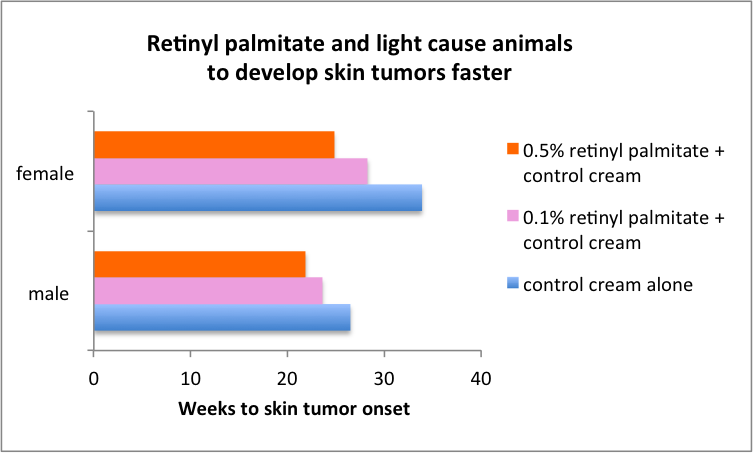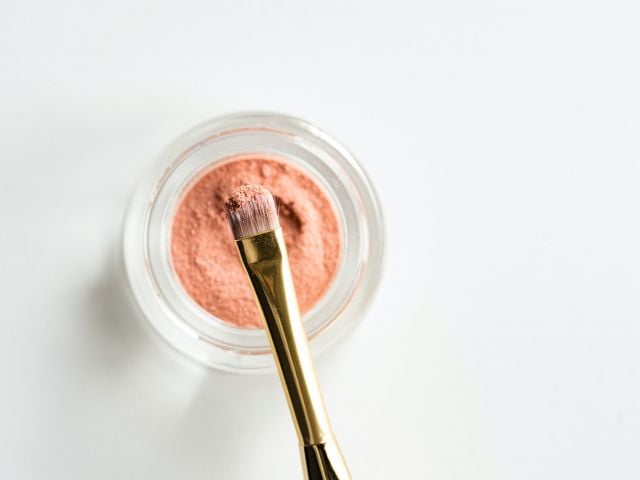
By Sonya Lunder, M.P.H., EWG Senior Analyst
The federal Food and Drug Administration’s new sunscreen rules seem likely to do away with the worst hype in ads and on labels. The agency has barred the claims “waterproof,” “sweatproof” and “sunblock,” boasts that were never achievable. The FDA has, for the first time, set a minimum performance standard for sunscreens that use the term “broad spectrum” to denote that they provide a measure of protection from ultraviolet-A rays.
But the rules issued June 14, to take effect in the summer of 2012, address what’s on the outside of the bottle, not what’s in it. Nearly 33 years after it began considering regulation of sunscreen products, the FDA has yet to review or certify the safety of chemicals formulated into sunscreen products.
A particularly troublesome regulatory gap involves a vitamin A derivative called retinyl palmitate, often found in sunscreens and other products used on the skin. For some years, government and independent scientists have been investigating this chemical as a possible photocarcinogen – meaning that it may speed the development of skin tumors and lesions on sun-exposed skin.
The most recent government scientific study, made public last January by the National Toxicology Program, an interagency group housed within the National Institutes of Health, has demonstrated that retinyl palmitate speeds photo-carcinogenic effects on test animals. The study, entitled Photococarcinogenesis Study Of Retinoic Acid And Retinyl Palmitate and conducted at a federal research center co-hosted by the FDA and NTP, found that mice treated with small doses of retinyl palmitate and ultraviolet light developed skin tumors faster than untreated, light-exposed mice or those treated only with a control cream. There were more numerous tumors on every animal treated with retinyl palmitate.

This graphic presents skin tumor onset data for female and male mice exposed to the amount of UV light equivalent to 30 percent of the UV dose that causes sunburn in people (UV intensity of 6.75 CIE/cm2). The bottom axis, from 0 to 40, indicates weeks of retinyl palmitate + light treatment. At the beginning of the study animals were 8 weeks old. The combination of retinyl palmitate and UV exposure caused earlier onset of skin tumors. Similarly, earlier tumor onset was observed in animals exposed to twice higher intensity of UV light (13.7 CIE/cm2, equivalent to 60 percent of the amount of UV that causes sunburn). Throughout the treatment, the mice received skin applications of 0.1 percent or 0.5 percent retinyl palmitate mixed in a control skin cream containing a solvent diisopropyl adipate at 15 percent every weekday. Animals were also exposed to UV light on weekdays (NTP 2010).
A panel of independent scientists convened by the NTP on January 26 unanimously confirmed the study’s conclusion that retinyl palmitate “enhanced the photocarcinogenic activity” of sunlight (NTP 2011).
The strong scientific consensus that has formed around the NTP-FDA vitamin A study has afforded the FDA an exceptional opportunity to take a bold public health stand on a cosmetic ingredient that has proven harmful in multiple studies.
Instead, FDA has decided to await further investigation before making any determination about the safety of retinyl palmitate.
Vitamin A is an essential nutrient found in plant and animal-based foods and is intentionally added to some products like milk. Moderate intake of vitamin A-rich foods or dietary supplements is essential for health; it has been also reported to reduce skin cancer in organ transplant recipients (Zwald 2010). Dermatologists have long used synthetic forms of vitamin A for treating acne and skin disorders. These medicinal preparations are available only by prescription.
Over the past decade, forms of vitamin A called topical retinoids, particularly retinyl palmitate, have been blended into numerous cosmetic products and sunscreens (NTP 2000). The aim is to even out skin discoloration, reduce roughness and wrinkling (Sorg 2006). Neither FDA nor the cosmetics industry keeps close tabs on the extent of vitamin A use in cosmetics. But EWG’s Skin Deep database shows that various forms of vitamin A are found in hundreds of sunscreens, skin lotions, lipsticks and lip sunscreens, products used on sun-exposed skin.
Vitamin A and its derivatives are well known to cause skin irritation and greater skin sensitivity to sunlight, a reaction known as photosensitivity (Reid 1996). Patients administered treatments with a form of vitamin A called retinoic acid are routinely instructed to apply products at night if possible and to practice strict sun avoidance (DailyMed 2010, Levin 2010).
As early as 2000 the FDA took note of the proliferation of vitamin A derivatives in cosmetics and nominated them for extensive study (NTP 2000a). In 2001, the National Center for Toxicology Research, a joint NTP-FDA research center, launched a series of studies designed to test the behavior of retinyl palmitate on sun-exposed skin (Fu 2002, NTP 2000b).
Since then, scientists at the National Center for Toxicology Research have published more than a dozen studies showing that vitamin A derivatives react with UV light to form harmful free radicals that are toxic to the skin or that break down to harmful chemical byproducts (Tolleson 2005, Yin 2007, Fu 2007). Light-induced breakdown products of vitamin A damage skin lipids and DNA strands, eventually creating skin lesions and potentially contributing to tumor formation (Cherng 2005, Mei 2005, 2006, 2009 2010, Xia 2006, Yan 2005, NTP 2010).
The federal research agenda culminated with a one-year cancer study that coated mice with creams pre-loaded with retinyl palmitate at levels typically found in cosmetics (CIR 2007, FDA 2002, NTP 2000). The animals were then exposed to ultraviolet light whose intensity was equivalent to human sun exposure. Retinoic acid, a highly potent form of vitamin A, was used as a positive control, since its photocarcinogenic properties have been observed in many previous studies (NTP 2000). The test used hairless mice of the strain known as SKH-1, considered the gold standard for photocarcinogenicity testing (Benevides 2009).
The test animals were irradiated for several hours each weekday for 40 weeks, at two different levels of ultraviolet light intensity, 6.75 and 13.7 mJ CIE/cm2, equivalent to 30 and 60 percent of the amount of ultraviolet light that causes sunburn in people (known as a “minimal erethymal dose”). According to an FDA publication, the higher ultraviolet light dose is equivalent to nine minutes of unprotected exposure to highest intensity UV light (Yan 2007). The mice received topical applications of creams containing 0.1 percent, 0.5 percent, 1 percent, or 2 percent retinyl palmitate or retinoic acid mixed in a skin cream containing diisopropyl adipate, a solvent, at 15 percent to dissolve the retinoid. Comparison groups were treated with cream containing diisopropyl adipate but no vitamin A.
NTP scientists examined the timing and number of skin tumors and lesions in animals treated with differing amounts of retinyl palmitate and retinoic acid relative to the comparison groups. They noted skin damage among animals treated with the vitamin-free cream and exposed to ultraviolet light, but even higher rates of damage among animals treated with cream laced with retinyl palmitate or retinoic acid. When the peer review panel studied the study’s draft findings last January, it concluded unanimously:
“Compared to the control cream, retinyl palmitate further enhanced the effects of SSL [simulated solar light] in SKH-1 mice based upon earlier onsets and increased multiplicities of in-life skin lesions.
“Compared to the control cream, retinyl palmitate further enhanced the photocarcinogenic activity of SSL [simulated solar light] in SKH-1 mice based upon increased incidences and multiplicities of squamous cell neoplasms of the skin” (NTP 2011).”
The NTP data show a clear, dose-related acceleration of skin damage when retinyl palmitate was added to the test cream.
Independent studies have found that vitamin A derivatives are photocarcinogenic. While there is diversity among the findings in the scientific literature (So 2004), most studies find that retinoic acid causes skin cancer on sun-exposed skin. One variable factor in the photocarcinogenicity studies appears to be the intensity of UV light. As noted by NTP (2000b), when UV radiation was minimal, topical retinoic acid generally enhanced photocarcinogenesis.
At least seven studies conducted between 1977 and 2008 found evidence of retinoic acid photocarcinogenicity (Epstein 1977, Forbes 1979, Forbes 1981, Davies 1988, Hartmann 1981, Halliday 2000, Lerche 2008). In contrast, studies using UV radiation from unfiltered sources that emit UVC radiation (which is not present in terrestrial sunlight) (Brown 2000) or at levels exceeding the human minimal erythema dose found that topically-applied retinoic acid did not affect or even inhibited photocarcinogenesis (Epstein 1981, Kligmann 1981a, Kligmann 1981b).
The widespread use of retinyl palmitate in sunscreen exemplifies the weaknesses of current government regulation of cosmetics and sunscreen products. The FDA has limited and rarely-exercised authority to remove unsafe products from the market (FDA 2005). Retinyl palmitate is a non-essential component of sunscreen. It is marketed for putative anti-aging skin benefits.
The FDA-NTP study found an unanticipated effect: skin damage that might be linked to the solvent diisopropyl adipate. The rates of skin damage in the group treated with cream and diisopropyl adipate but no retinoid caused FDA to question whether the solvent was also acting as a photocarcinogen and might be responsible for some skin tumors and lesions (FDA 2011). This bears further scrutiny. Diisopropyl adipate can be found in 75 body care ingredients in EWG’s Skin Deep database; 47 of these products also contain retinyl palmitate, and many of them are also sunscreens (EWG 2011).
EWG supports FDA’s proposal for further testing to determine the potential phototoxicity and/or photocarcinogenicity of diisopropyl adipate. However, more tests are likely to take some years. There is already ample evidence to advise consumers to avoid sunscreens, body lotions, and lip products with retinyl palmitate.
The sunscreen industry and its paid consultants have rejected the NTP findings. They defend the continued use of retinyl palmitate in sunscreens (Gallon 2010, Kotz 2010). In a commentary in the Journal of the American Academy of Dermatology, Henry Lim, Steven Wang, and Stephen Dusza incorrectly asserted that “there is no published evidence to suggest that topical retinoids increase the risk of photocarcinogenesis” (Wang 2010). There has also been no discernable change in the number of sunscreen products containing retinyl palmitate since the NTP study reports were publicized. Therefore it appears that the cosmetics industry is bent on continuing the unnecessary use of topical retinoids (Burnett 2011) even though multiple studies point to the risks of indiscriminate use of these chemicals in personal care products.
To address the broader issue of cosmetic safety, FDA must follow up its detailed toxicity testing with action to remove harmful ingredients from body care products.
Yet, as FDA Office of Cosmetics and Colors acknowledges, FDA has little authority to regulate the uses of ingredients in cosmetics, monitor adverse effects or restrict ingredients shown to be harmful (FDA 2005).
Ingredient reviews are outsourced to an industry-funded review team, the Cosmetics Ingredient Review, which reviewed the cosmetics use of retinol and retinyl palmitate in 1987 and 2005. This body noted toxicity concerns for retinyl palmitate but concluded there was no need to change its stance that the chemical was safe at concentrations of up to 5 percent (CIR 1987; CIR 2007).
EWG urges FDA to expedite review of the latest scientific evidence bearing on the safety of forms of vitamin A and other common sunscreen ingredients that may be toxic or carcinogenic.
Until the government takes decisive action, consumers can have no confidence that the regulatory system for sunscreens and cosmetics is screening out suspect ingredients. With no clear guidance from the FDA, consumers must rely on tools like EWG’s sunscreen guide and Skin Deep database to identify and avoid suspect ingredients in common products.


